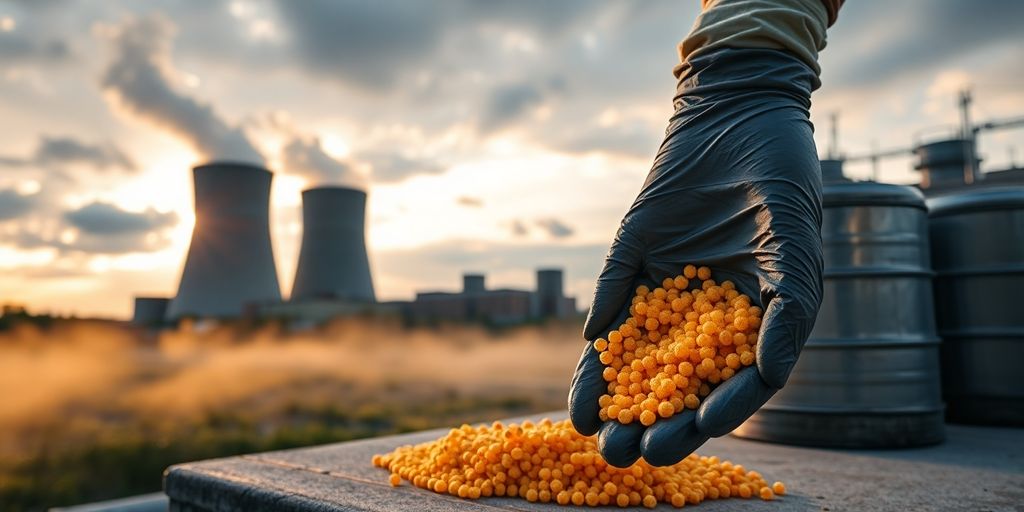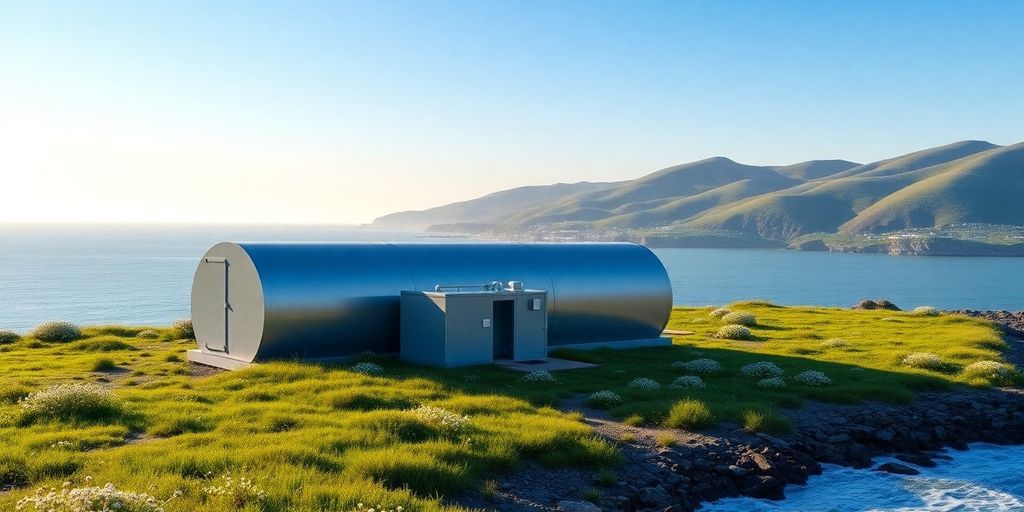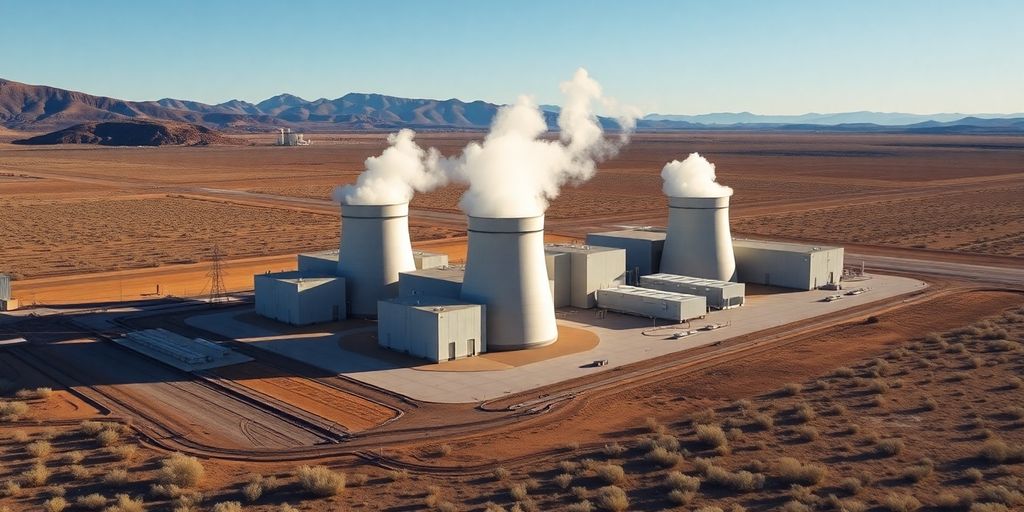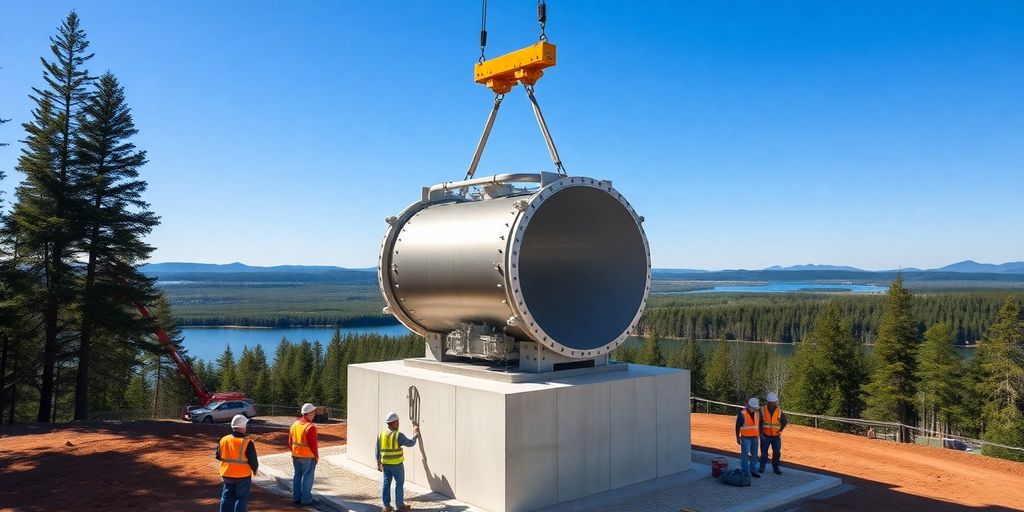I spent some time looking into Uranium Supply & Shortages and it’s clear the market is on a knife’s edge. New small reactors and AI centers are boosting demand just as aging mines hit their limits. At the same time, some regions hold most of the supply, leaving others scrambling. Here’s a quick rundown of what you need to know.
Key Takeaways
- Demand is surging thanks to new small modular reactors and AI data centers.
- A few top players control most of the mining and enrichment, so many countries have to import to cover their use.
- Analysts warn that if new mines and enrichment capacity don’t come online soon, gaps may grow by 2030.
- Canada leads global output, the US leans on foreign uranium, and Africa and Australia could become bigger suppliers.
- New extraction methods, spent fuel recycling, and strategic stockpiles can help avoid deep shortages later.
Amplifying Demand Trends In Nuclear Energy Markets
Nuclear energy is seeing a real resurgence, and it’s not just talk. Several factors are converging to drive up demand for uranium, the fuel that powers these plants. It’s a mix of new technologies, growing energy needs, and a renewed focus on reliable, low-carbon power. Let’s take a look at what’s fueling this demand.
Impact Of Small Modular Reactors On Uranium Needs
Small Modular Reactors (SMRs) are gaining traction as a flexible and scalable alternative to traditional large nuclear plants. The thing is, even though they’re smaller, a bunch of them being built still adds up to a significant increase in uranium demand. The construction surge in SMRs is expected to put serious pressure on uranium supplies.
SMRs offer several advantages, including lower upfront costs and the ability to be deployed in locations unsuitable for larger reactors. However, their widespread adoption hinges on overcoming regulatory hurdles and establishing robust supply chains for fuel and components.
Role Of AI Infrastructure In Fuel Consumption
AI is the new kid on the block, and it’s hungry for power. All those data centers and complex calculations require massive amounts of electricity. Tech leaders are starting to realize that nuclear power is one of the only scalable, reliable solutions to drive the AI revolution. People like Sam Altman are even investing in companies like Oklo, which is pioneering next generation nuclear reactors. This is a big deal because it signals that the tech industry sees nuclear as a key part of its future. As more tech companies look for clean, reliable energy, Future Fuels Inc. is in an ideal position to capitalize.
Global Nuclear Revival And Resource Pressure
Across the globe, countries are re-evaluating nuclear power as a way to meet growing energy demands and reduce carbon emissions. This revival is putting a strain on existing uranium supplies, and many analysts think this is just the beginning. Current forecasts highlight a looming uranium supply gap that will only intensify as more countries adopt nuclear power to support their energy grids and AI infrastructure. The International Energy Agency projects global nuclear capacity will rise significantly by 2050, further increasing the pressure on uranium resources. The need for low-cost continuous, reliable supply can be distinguished from peak demand occurring over a few hours daily and able to command higher prices. Supply needs to match demand instantly and reliably over time.
Here’s a quick look at the projected growth in nuclear capacity:
| Region | Projected Growth by 2050 | Key Drivers |
|---|---|---|
| Asia Pacific | Significant Increase | Growing energy demand, decarbonization goals |
| North America | Moderate Increase | Grid reliability, clean energy mandates |
| Europe | Variable | Energy security, climate targets |
To summarize, the demand for uranium is going up, and it’s being driven by a combination of factors. This could cause uranium prices to soar, creating a big opportunity for companies in the uranium market.
Here are some key takeaways:
- SMRs are increasing uranium demand.
- AI infrastructure needs reliable power.
- Global nuclear revival is straining resources.
Mapping Current Uranium Supply Landscapes
Leading Global Uranium Producers
So, where does all the uranium actually come from? It’s not like you can just pick it up at the corner store. A few countries really dominate the uranium mining scene. Kazakhstan has been the top dog for a while now, accounting for a huge chunk of global production. Canada is another big player, with some seriously high-grade deposits. Australia also kicks in a significant amount. It’s worth keeping an eye on these countries because any disruption to their output can send ripples through the entire market.
Shortfall In Domestic Production Versus Consumption
Okay, here’s a tricky bit: a lot of countries that use a lot of uranium don’t actually produce much themselves. Take the U.S., for example. It has a bunch of nuclear reactors, but its domestic uranium production is pretty small compared to what it needs. This means it relies on imports to fill the gap. This reliance on foreign sources can be a bit of a headache, especially when geopolitical realignments start to shift. It makes energy security a real concern. The same goes for a lot of European countries. They’re trying to diversify their supply chains, but it’s not always easy.
Mining And Enrichment Capacity Constraints
It’s not just about digging the uranium out of the ground; you also need to enrich it before it can be used in most reactors. Enrichment is a whole other ballgame, and there are only a limited number of facilities that can do it. Russia has historically been a major player in the enrichment market, but things are changing.
The thing is, building new mines and enrichment plants takes time – a lot of time. We’re talking years, maybe even a decade or more, from initial exploration to actual production. That’s a problem when demand is rising quickly. It creates a bottleneck that can lead to shortages and price spikes. Plus, there are environmental regulations and public concerns to deal with, which can slow things down even further.
Here’s a quick look at some of the challenges:
- Long Lead Times: New projects take years to develop.
- Environmental Concerns: Mining has environmental impacts that need to be managed.
- Limited Enrichment Capacity: Only a few facilities can enrich uranium.
Projections For Future Uranium Supply & Shortages
It’s tough to look into the future, but when it comes to uranium, some trends are becoming pretty clear. Demand is going up, and there are questions about whether supply can keep pace. Let’s break down some of the projections.
Estimated Supply Deficits Through 2030
Okay, so here’s the deal: a bunch of analysts are saying we could see a big uranium shortage by 2030. How big? Some estimates suggest a deficit of over 100 million pounds. That’s a lot! It’s like, imagine baking a cake and realizing you’re missing half the flour. Not good. This isn’t just some minor blip; it’s a real concern if nuclear energy is going to keep growing like everyone expects.
Structural Challenges In New Mine Development
Why can’t we just dig more mines? Well, it’s not that simple. Opening a new uranium mine is a huge undertaking. It takes years – sometimes over a decade – from finding a deposit to actually getting uranium out of the ground. There are environmental regulations, getting permits, raising money, and then the actual mining. It’s a long and expensive process. Plus, the easy-to-reach deposits are mostly gone, so we’re talking about more complex and costly projects.
Price Signal Limitations In Market Balancing
You’d think that if uranium prices go up, more mines would open, and everything would balance out, right? That’s the theory, but it doesn’t always work that way. The problem is that the uranium market is weird. Utilities that buy uranium are very cautious. They don’t want to get burned by high prices, so they often sign long-term contracts. These contracts can limit how much prices can rise, which means the price signal might not be strong enough to encourage new mines to open quickly enough.
It’s a bit of a catch-22. We need higher prices to incentivize new supply, but the way the market works can keep prices from rising enough, fast enough. This could lead to a situation where demand outstrips supply for a while, causing some headaches for the nuclear industry.
Here’s a quick look at potential supply gaps:
| Year | Estimated Deficit (Millions of Pounds) |
|---|---|
| 2025 | 5 |
| 2027 | 25 |
| 2030 | 80+ |
These are just estimates, of course, but they paint a picture of a market that could be under a lot of pressure in the coming years.
Regional Strengths And Vulnerabilities In Uranium Markets

Canadian Production Dominance
Canada has been a major player in the uranium market for a while, and it’s not showing signs of slowing down. The country boasts some of the world’s highest-grade uranium deposits, making it a cost-effective producer. This gives Canada a significant advantage in meeting global demand. However, reliance on a single region can create vulnerabilities if unforeseen events disrupt production. For example, labor disputes or environmental concerns could impact supply.
- High-grade deposits reduce mining costs.
- Established infrastructure supports production.
- Political stability encourages investment.
U.S. Dependence On Foreign Uranium
The United States, despite having a large number of nuclear reactors, relies heavily on foreign sources for its uranium. Domestic production is just a fraction of what’s needed to fuel its nuclear fleet. This dependence creates a strategic vulnerability, especially given the current geopolitical climate. Any disruptions to the global supply chain could have serious consequences for U.S. energy security. The Fordow and Natanz nuclear sites are examples of geopolitical hotspots that could impact the uranium sector.
Relying on other countries for a critical resource like uranium can be risky. It means the U.S. is subject to the policies and priorities of those nations, which may not always align with its own.
Emerging African And Australian Supply Hubs
While Canada remains a top producer, Africa and Australia are emerging as significant players in the uranium market. Countries like Namibia, Niger, and Australia have substantial uranium reserves and are actively developing new mining projects. This diversification of supply sources is good for the overall stability of the market. However, these regions also face challenges, including political instability, infrastructure limitations, and environmental regulations, which could affect their ability to ramp up production quickly.
| Region | Key Producers | Potential | Challenges |
|---|---|---|---|
| Africa | Namibia, Niger | High | Political instability, infrastructure |
| Australia | Various | High | Environmental regulations, remote locations |
Innovations And Technologies To Alleviate Uranium Shortages

It’s no secret that the uranium market is facing potential shortages. Luckily, some pretty cool innovations are in the works to help ease the pressure. From better ways to get uranium out of the ground to reusing old fuel, there’s a lot happening. These advancements could really change the game and help keep the nuclear energy sector running smoothly.
Advances In Uranium Extraction Techniques
Traditional uranium mining can be tough on the environment and expensive. But, new techniques are emerging that could make things easier and cleaner. One promising area is in-situ leaching (ISL), where solutions are pumped into the ground to dissolve uranium, then pumped back up. This method can reduce the surface disruption compared to open-pit or underground mining. Another area of development is improved ore processing, which aims to extract more uranium from the ore with less waste. These advances could significantly increase the amount of usable uranium we can get from existing resources.
Here’s a quick look at some extraction methods:
- In-Situ Leaching (ISL): Dissolves uranium underground and pumps it to the surface.
- Heap Leaching: Crushed ore is piled up and chemicals are used to dissolve the uranium.
- Direct Uranium Extraction (DUE): Aims to selectively extract uranium from various sources, including seawater.
Recycling And Reprocessing Of Spent Fuel
What if we could reuse the fuel that’s already been used in nuclear reactors? That’s the idea behind recycling and reprocessing spent nuclear fuel. Spent fuel still contains a lot of usable uranium and plutonium. Reprocessing separates these materials from the waste products, allowing them to be fabricated into new fuel. This can reduce the amount of fresh uranium needed and also decrease the amount of high-level nuclear waste that needs to be stored. However, reprocessing is complex and expensive, and there are concerns about nuclear proliferation. Still, it’s a technology with the potential to significantly extend our uranium resources. The uranium bull market is pushing innovation in this area.
Development Of Low-Enriched Uranium Alternatives
Most nuclear reactors use low-enriched uranium (LEU), which has a U-235 concentration of less than 20%. However, some research reactors use high-enriched uranium (HEU), which poses a greater security risk. There’s a big push to convert these reactors to use LEU instead. Another area of development is accident-tolerant fuels (ATF), which are designed to be more resistant to extreme conditions in a reactor. These fuels can improve safety and potentially allow reactors to operate more efficiently, reducing the amount of uranium needed. These alternatives are important for long-term power solutions.
Developing alternative fuel sources and extraction methods is not just about addressing potential shortages; it’s about creating a more sustainable and secure energy future. By investing in these innovations, we can reduce our reliance on traditional uranium sources and minimize the environmental impact of nuclear power.
Strategic Responses To Stabilize Uranium Supply & Shortages
Okay, so the uranium market is looking a little shaky, right? Demand is going up, but supply? Not so much. So, what can we actually do about it? It’s not like we can just magically make more uranium appear. We need some serious strategies to keep things stable.
Government Policy And Strategic Reserves
Governments have a big role to play here. Think about it: they can set policies that encourage domestic uranium production, or they can build up strategic reserves, kind of like an emergency stash. These reserves can act as a buffer if there’s a sudden supply disruption.
- Incentivizing domestic mining through tax breaks or subsidies.
- Establishing national uranium stockpiles.
- Streamlining the licensing process for new uranium projects (while still being safe, of course).
It’s a balancing act. Governments need to support the industry without creating a free-for-all that could harm the environment or local communities. Smart regulation is key.
Industry Partnerships For Supply Security
Companies can’t just sit around waiting for governments to fix everything. They need to work together too. That means forming partnerships to secure long-term uranium supply. Think joint ventures, long-term contracts, and even sharing technology.
- Joint ventures between mining companies and nuclear power plant operators.
- Long-term supply contracts to provide price stability.
- Collaborative research and development to improve extraction and enrichment technologies.
Investment Strategies For Long-Term Market Balance
Ultimately, it all comes down to money. We need serious investment in the uranium sector to avoid shortages. That means attracting investors to new mining projects, enrichment facilities, and even recycling technologies. But investors need to see a clear path to profitability.
- Providing loan guarantees or other financial incentives for new projects.
- Supporting research into advanced nuclear fuel cycles.
- Creating a stable and predictable regulatory environment to attract investment.
Here’s a quick look at potential investment areas:
| Investment Area | Potential Impact |
|---|---|
| New Mining Projects | Increases overall uranium supply |
| Enrichment Facilities | Reduces reliance on foreign enrichment services |
| Recycling Technologies | Extends the lifespan of existing uranium resources |
## Conclusion
Uranium supply and demand are heading for a tight squeeze. New mines can help, but they take years to get going. Reactor orders keep coming, which piles on the pressure. Deals that lock in future deliveries could ease the crunch. Regulators and companies need to act now, not later. It sounds simple, but we all know it’s not. Still, with clear steps and some elbow grease, we can keep nuclear power running without nasty surprises.
Frequently Asked Questions
What is uranium used for in nuclear energy?
Uranium is the main fuel that powers nuclear reactors. It heats water to make steam, which drives turbines to create electricity.
Why could there be a shortage of uranium soon?
Demand for nuclear power is growing fast while new mines take many years to start. This gap between how much we need and how much we mine can lead to shortages.
How do small modular reactors change uranium needs?
Small modular reactors use less fuel per unit, but having more of them can still raise overall demand. Their faster build times can speed up uranium use across the market.
Can recycling spent nuclear fuel help ease shortages?
Yes. Spent fuel contains uranium and plutonium that can be recovered and made into new fuel. Recycling reduces waste and stretches our uranium supply.
Which countries make the most uranium today?
Canada, Australia, and Kazakhstan lead the world in uranium output. They supply a big share of the fuel used by reactors around the globe.
What steps can stabilize uranium supply and demand?
Governments can set up strategic reserves and speed up permits for new mines. Companies can also form partnerships to share resources and invest in better extraction methods.












